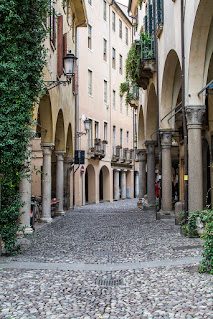Fascinating area preserves Jewish heritage in the city
A small district known as the Ghetto, situated within
Padua’s historic centre, still has many shops where craftsmen follow the
traditional occupations of Jewish residents in the city.
A narrow, cobbled street in
the Ghetto area of Padua
Jews are recorded as living in Padua as far back as
the 13th century. The city was one of the great centres of medieval Judaism,
with a celebrated rabbinical academy where students from all over Europe came
to study.
Students were also attracted to Padua by its very old
medical school, which was the only one to accept Jews.
In 1548 the Venetian authorities decided to require all
Jews to reside in an area near Piazza delle Erbe that was called the Ghetto.
However, Jewish students were still allowed to graduate from Padua’s
prestigious university.
From 1609 all four streets leading to the Ghetto were
closed at a certain hour of the evening and guarded gates isolated the district
during the night.
The Ghetto was officially abolished in 1797 after Napoleon’s
proclamation of the equality of all citizens.
By the 19th century there were three synagogues in the
district, reflecting the number of Jewish people then living in Padua.
The number of Jewish residents was greatly reduced in
the 20th century and today there is only one synagogue still open for worship, at
number 9 Via San Martino e Solferino, where the offices of the Jewish community
are also located. Piazza delle Erbe, close to the area of Padua
where Jewish residents were required to live
This synagogue was originally built in 1548 but has
been restructured several times. One of the four original gates to the Ghetto,
crowned with the lion of Saint Mark, stands nearby.
Full equality for Jewish citizens was achieved in 1866
when Padua was annexed to the Kingdom of Italy.
The former Ghetto has kept much of its original
appearance, with the tall narrow houses in Via Arco evoking how the Ghetto must
have looked in the past.
The Jewish Heritage Museum at 26 Via delle Piazze, just
off Piazza delle Erbe, has precious objects on display that were taken from the two
former synagogues no longer in existence, some of them dating back to the 15th
century.

No comments:
Post a Comment